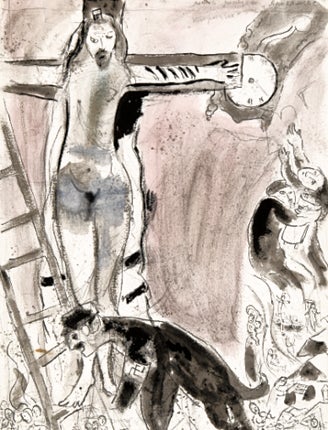Cross Purposes: Shock and Contemplation in Images of the Crucifixion, Ben Uri Gallery, London

Can there be any motif more common in the Western canon than the crucifixion of Jesus Christ? And yet when we come to consider the painted images of Christ on the cross that we best remember, we think of the Italian Renaissance, of Masaccio, Raphael, Michelangelo and others. And perhaps of the 17th century too – Zurbaran, for example. After that, we begin to falter. This important exhibition at the London Jewish Museum of Art invites us to consider how the idea of the crucifixion was seized upon by painters of the 20th century, and whether its meaning changed because of the history of that century. Just as importantly, it examines the meaning that the crucifixion came to have for Jewish painters, such as Marc Chagall.
The crucifixion of Christ was once a taboo subject for Jewish artists. Various factors combined to make this so: the fact that a practising Jew (like a practising Muslim) is forbidden to create graven images of the deity; the fact that Jews had suffered the calumny of being seen as the murderers of Christ. And then, in the 20th century, that taboo was swept aside. Why?
Because, as this exhibition reveals, the suffering of Christ on the cross began to assume a greater and more generic significance, largely as a result of the Holocaust. Jewish and Gentile painters seized it as a symbol of suffering in general – and of the Jews in particular.
Chagall, in Apocalypse in Lilac, Capriccio (1945) shows near universal anguish. A helpless Christ hangs above a crouching, uniformed Nazi, one of whose arms has been amputated. The Nazi is in the process of removing a ladder from the cross on which Jesus hangs. A clock falls from the sky. One of its hands is missing. Time stands still in this moment of arrested horror. Surrounding the cross, a medley of wispily drawn and painted skeletal figures are enacting terrible scenes.
In Emmanuel Levy's Crucifixion, of 1942, it is an orthodox Jew who is hanging from the cross, wrapped in a prayer shawl. Jews are the scapegoats of Western Europe, the victims of genocide. The mocking letters "INRI", which are usually displayed at the top of the cross, have been replaced by "JUDE", written in blood.
Each painter shows us a different Christ. In a David Jones painting of 1921 it is the stoical Redeemer, at one with the Welsh landscape from which the cross has been fashioned. Michael Rothenstein, painting at the height of the Spanish Civil War in 1937, shows us Christ and the two thieves as perfectly ordinary working men, their trousers held up by braces. Another day, another outbreak of human cruelty. The painting is chillingly matter of fact.
There are painters here whose interest in the crucified Christ is something of a surprise – Craigie Aitchison, that master of whimsy, shows us a ghostly figure being observed by a slightly bemused Bedlington terrier. In Gilbert Spencer's Crucifixion of 1915, burly young locals have been heaving the cross upright with the saviour in position – just another of the day's many tasks. As in the paintings of his brother, Stanley, the ordinary and the epiphanic go hand in hand.
To 28 November (www.benuri.org.uk)
Subscribe to Independent Premium to bookmark this article
Want to bookmark your favourite articles and stories to read or reference later? Start your Independent Premium subscription today.

Join our commenting forum
Join thought-provoking conversations, follow other Independent readers and see their replies